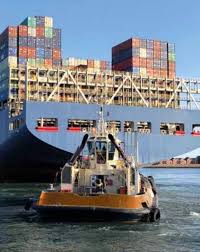Carrier Grounding Points to Gaps in Port’s Risk Assessment

What happened to ground the carrier?
The fully laden dry bulk carrier Orient Centaur was transiting the South Channel out of the Port of Weipa, Queensland, Australia, on November 6, 2017, under the conduct of harbor pilots as part of a trial introduction of mini Capesize vessels to the port.

Just over an hour after departing from the wharf, the ship’s main engine shut down due to a loss of water from a cracked engine cooling component
Propulsion was lost. Without the ability to steer, the ship grounded on the northern batter of the channel. The stern then slowly swung across the channel and grounded on the southern batter, effectively blocking the channel.
The hazards associated with engine failure had been considered as part of the port’s risk assessment for the introduction of mini Capesizes, and were to be mitigated by having tugs in attendance. Those hazards had only been considered, however, up to the point at which a ship had entered the South Channel. As a result, on the day of the occurrence, the tugs had been stood down and told to return to the berth after the Orient Centaur was steady in the South Channel.
Now, with the tide falling, there was a significant risk that the ship’s structural integrity would be compromised. The pilots estimated they had about 30 minutes to refloat the ship. A general call was issued to all tugs for assistance.
Three tugs were mobilized to the assistance of the grounded Orient Centaur
Under the guidance of the harbor pilots, the tugs were successfully used to refloat the ship. Orient Centaur was subsequently towed out of the channel to an anchorage.
Surveys conducted over the following days identified that the ship had not sustained any damage.
ATSB (Australian Transport Safety Bureau) Director of Transport Safety Stuart Macleod said that the incident highlighted the value of comprehensive risk assessments.
“In pre-trial simulations, the risks associated with engine failure during departure were only considered up to when a ship had entered the channel,” Mr. Macleod said.
The perfect storm of planning vs. reality
Consequently, the tugs were not in attendance to assist if propulsion was lost. Additionally, the tug masters had not been trained in the specifics of escort towage, nor in emergency response.
“This occurrence highlights the importance of considering potential hazards from end to end in order to provide the best opportunity to manage safety risk,” Mr. Macleod said.
In response to the occurrence, the Port of Weipa instituted new practices, with all departing ships over 200 m in length now having an escort tug made fast, from the wharf all the way through to the South Channel exit.
Recommendation for updated procedure
Separately, to address the engine failure issue, the ship’s managers have advised that cooling water is now tested weekly onboard the ship, as well as every six months at a shore laboratory. In addition, only manufacturers’ original spares are to be used during maintenance.
Read the ATSB investigation report.
Founded in 1988, the TapRooT® Root Cause Analysis System solves hurdles every investigator faces
TapRooT® Root Cause Analysis Training System takes an investigator beyond his or her knowledge to think outside the box. Backed with extensive research in human performance, incident investigation, and root cause analysis, TapRooT® is a global leader in improved investigation effectiveness and productivity, stopping finger-pointing and blame, improving equipment reliability, and fixing operating problems.

System Improvements, the creator of the TapRooT® System, has a team of investigators and instructors with years of extensive training ready to offer assistance worldwide.
TapRooT® Root Cause Analysis Training Courses are taught all over the world
If you are interested in learning how to stop repeat incidents, find a 2-Day or 5-Day course; or view the complete selection of TapRooT® courses. We are available to train you and your staff on-site at your workplace; Contact us to discuss your needs. You may also call us at 865.539.2139 to discuss any questions you may have.
Keep in touch to improve your problem-solving skills
We’re continually training, helping you improve your professional root cause analysis skills. Stay current with your TapRooT® Root Cause Analysis skills and training through:
- Following our blog;
- Free newsletters;
- Tuning in to TapRooT® TV Video Sessions or our podcasts;
- Connecting with us on Facebook, Twitter, Instagram, Pinterest, LinkedIn, and YouTube;
- And our annual Global TapRooT® Summit.



